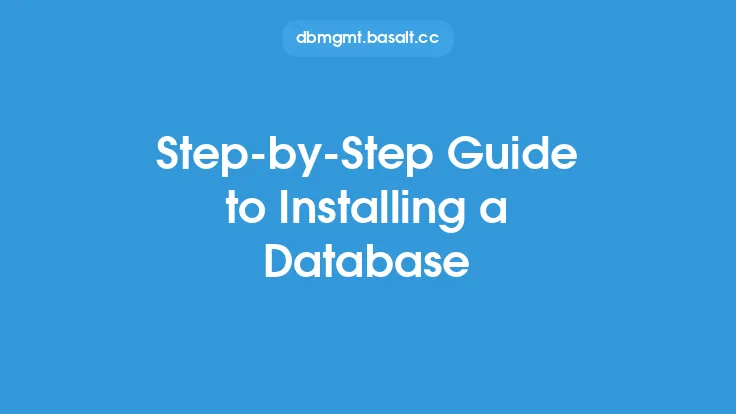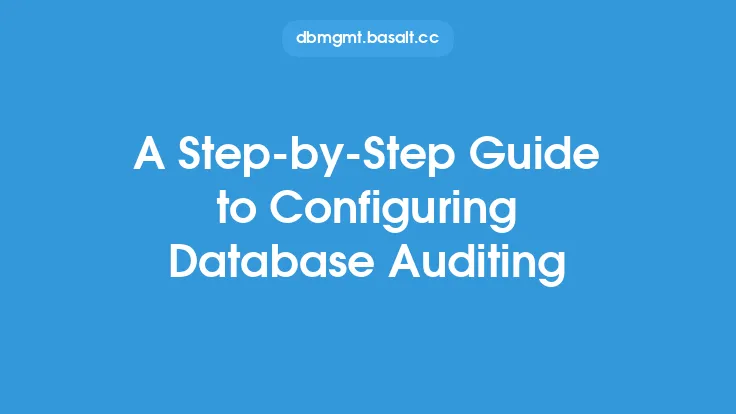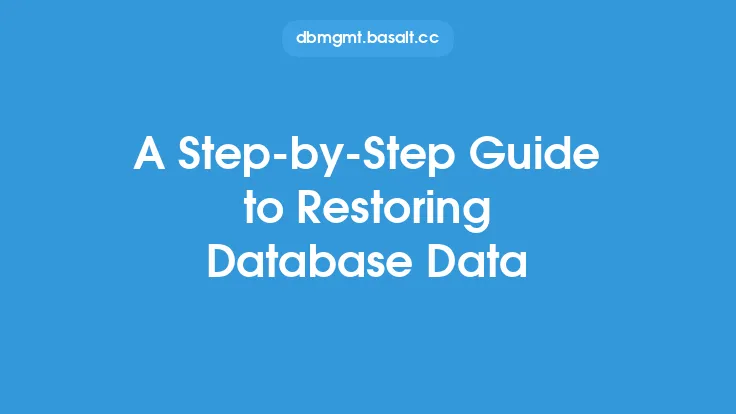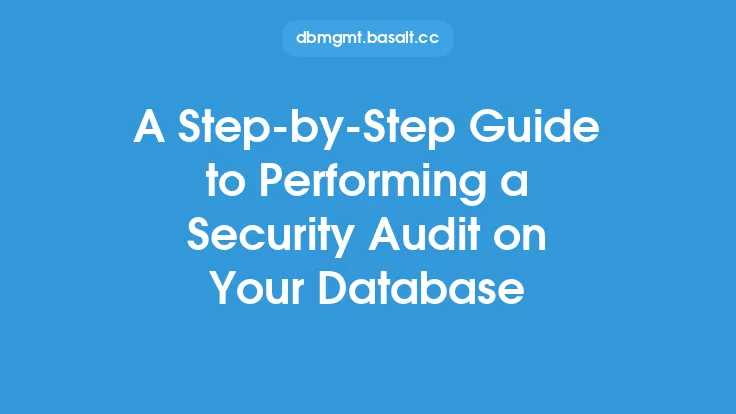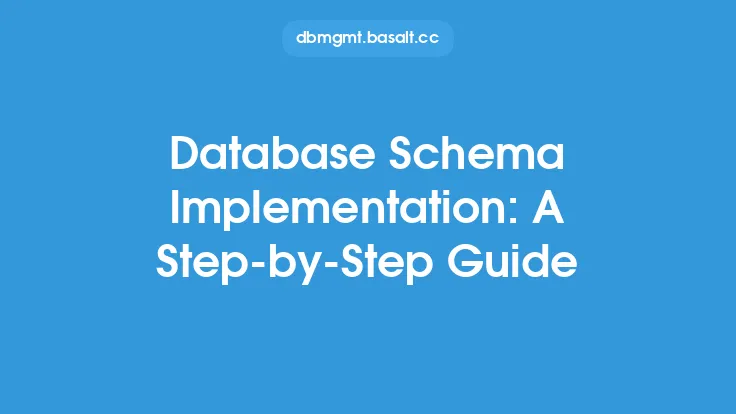Establishing a robust database governance framework is essential for any organization that relies on data to drive its operations. Database governance refers to the set of policies, procedures, and standards that ensure the effective management and use of an organization's data assets. In this article, we will provide a step-by-step guide on how to establish database governance, focusing on the key components, best practices, and technical considerations.
Introduction to Database Governance Components
To establish effective database governance, it is essential to understand the key components involved. These components include data quality, data security, data architecture, data storage, and data access. Data quality refers to the accuracy, completeness, and consistency of the data, while data security refers to the measures taken to protect the data from unauthorized access or breaches. Data architecture refers to the design and structure of the database, including the relationships between different data entities. Data storage refers to the physical or cloud-based infrastructure used to store the data, and data access refers to the mechanisms used to control and manage access to the data.
Assessing Current Database Environment
Before establishing database governance, it is crucial to assess the current database environment. This involves identifying the existing databases, data sources, and data systems, as well as the current data management practices and procedures. This assessment should also include an evaluation of the current data quality, data security, and data architecture. The goal of this assessment is to identify areas for improvement and to determine the scope of the database governance initiative.
Defining Database Governance Policies
Defining database governance policies is a critical step in establishing effective database governance. These policies should outline the rules and guidelines for data management, including data quality, data security, data access, and data retention. The policies should also define the roles and responsibilities of the different stakeholders involved in data management, including data owners, data stewards, and data users. The policies should be based on industry best practices and should align with the organization's overall data strategy.
Establishing Data Governance Roles and Responsibilities
Establishing clear data governance roles and responsibilities is essential for effective database governance. The key roles involved in data governance include data owners, data stewards, and data users. Data owners are responsible for the overall management and oversight of the data, while data stewards are responsible for the day-to-day management of the data. Data users are responsible for accessing and using the data in accordance with the established policies and procedures. It is essential to define the roles and responsibilities of each stakeholder and to ensure that they understand their obligations and expectations.
Implementing Data Quality Controls
Implementing data quality controls is a critical component of database governance. Data quality controls refer to the measures taken to ensure the accuracy, completeness, and consistency of the data. This includes data validation, data cleansing, and data normalization. Data validation involves checking the data for errors or inconsistencies, while data cleansing involves correcting or removing errors or inconsistencies. Data normalization involves transforming the data into a standard format to ensure consistency and comparability.
Implementing Data Security Measures
Implementing data security measures is essential for protecting the data from unauthorized access or breaches. This includes access controls, encryption, and auditing. Access controls refer to the mechanisms used to control and manage access to the data, including authentication, authorization, and access privileges. Encryption refers to the process of converting the data into a secure and unreadable format, while auditing refers to the process of monitoring and tracking access to the data.
Establishing Data Architecture Standards
Establishing data architecture standards is critical for ensuring the consistency and integrity of the data. This includes defining the data models, data structures, and data relationships. Data models refer to the conceptual representation of the data, while data structures refer to the physical organization of the data. Data relationships refer to the connections between different data entities. The data architecture standards should be based on industry best practices and should align with the organization's overall data strategy.
Implementing Data Storage and Retrieval Procedures
Implementing data storage and retrieval procedures is essential for ensuring the efficient and effective management of the data. This includes defining the data storage requirements, data retrieval procedures, and data backup and recovery procedures. The data storage requirements should be based on the organization's data needs and should take into account factors such as data volume, data growth, and data accessibility. The data retrieval procedures should be designed to ensure fast and efficient access to the data, while the data backup and recovery procedures should be designed to ensure the integrity and availability of the data in the event of a disaster or data loss.
Monitoring and Reviewing Database Governance
Monitoring and reviewing database governance is essential for ensuring the effectiveness and efficiency of the database governance framework. This includes monitoring data quality, data security, and data access, as well as reviewing the database governance policies and procedures. The monitoring and review process should be ongoing and should involve regular audits and assessments to identify areas for improvement. The goal of the monitoring and review process is to ensure that the database governance framework is aligned with the organization's overall data strategy and is meeting the needs of the organization.
Technical Considerations for Database Governance
From a technical perspective, database governance involves a range of considerations, including data modeling, data warehousing, and data integration. Data modeling refers to the process of creating a conceptual representation of the data, while data warehousing refers to the process of storing and managing large amounts of data. Data integration refers to the process of combining data from different sources into a single, unified view. The technical considerations for database governance should be based on industry best practices and should align with the organization's overall data strategy.
Best Practices for Database Governance
Best practices for database governance include establishing clear policies and procedures, defining roles and responsibilities, implementing data quality controls, and monitoring and reviewing database governance. It is also essential to establish a data governance framework that is aligned with the organization's overall data strategy and to ensure that the framework is flexible and adaptable to changing business needs. The best practices for database governance should be based on industry best practices and should take into account the unique needs and requirements of the organization.
Conclusion
Establishing effective database governance is essential for any organization that relies on data to drive its operations. By following the steps outlined in this article, organizations can establish a robust database governance framework that ensures the effective management and use of their data assets. The key components of database governance include data quality, data security, data architecture, data storage, and data access, and the technical considerations include data modeling, data warehousing, and data integration. By implementing best practices and monitoring and reviewing database governance, organizations can ensure the integrity, availability, and usability of their data assets.
